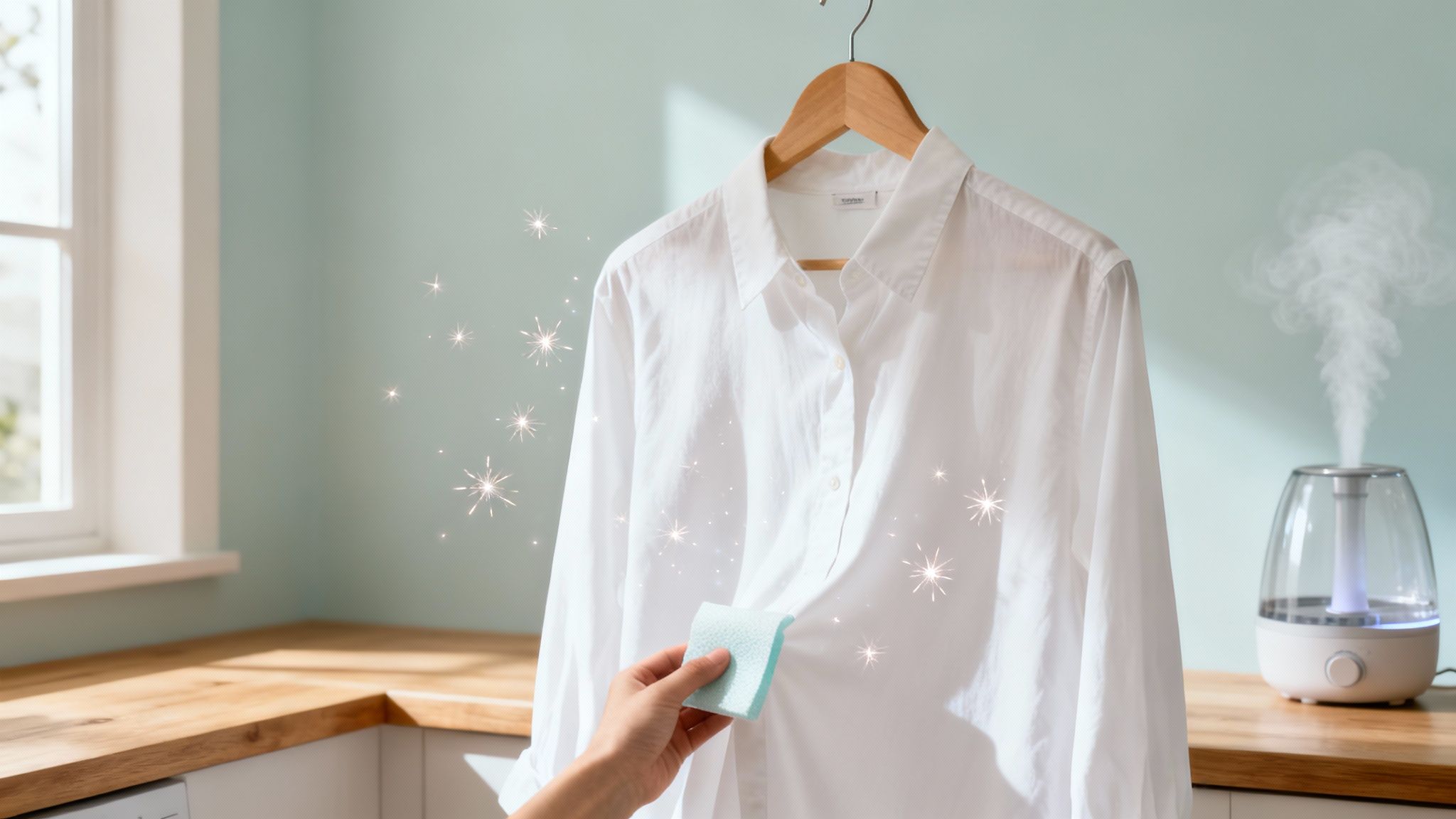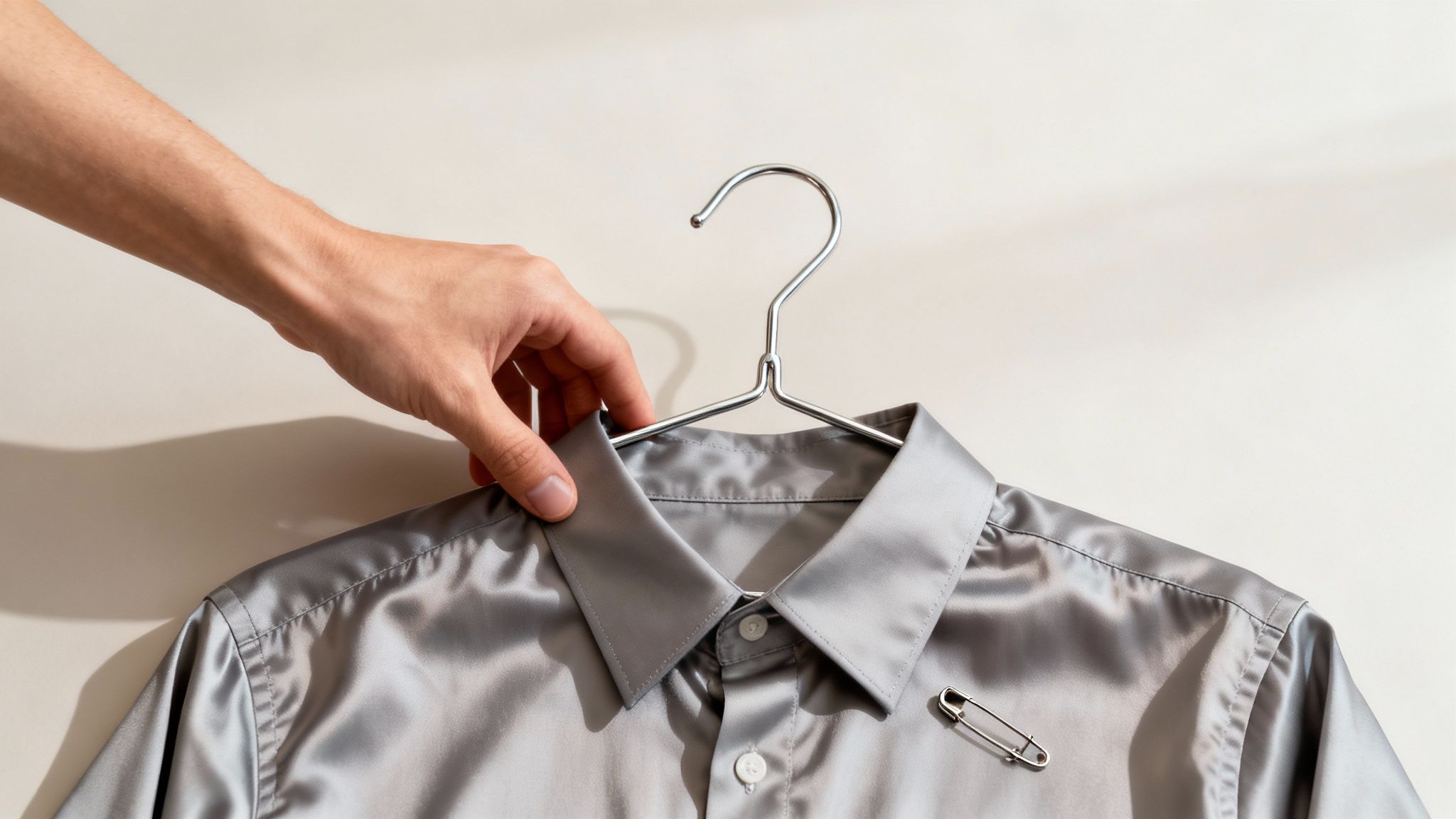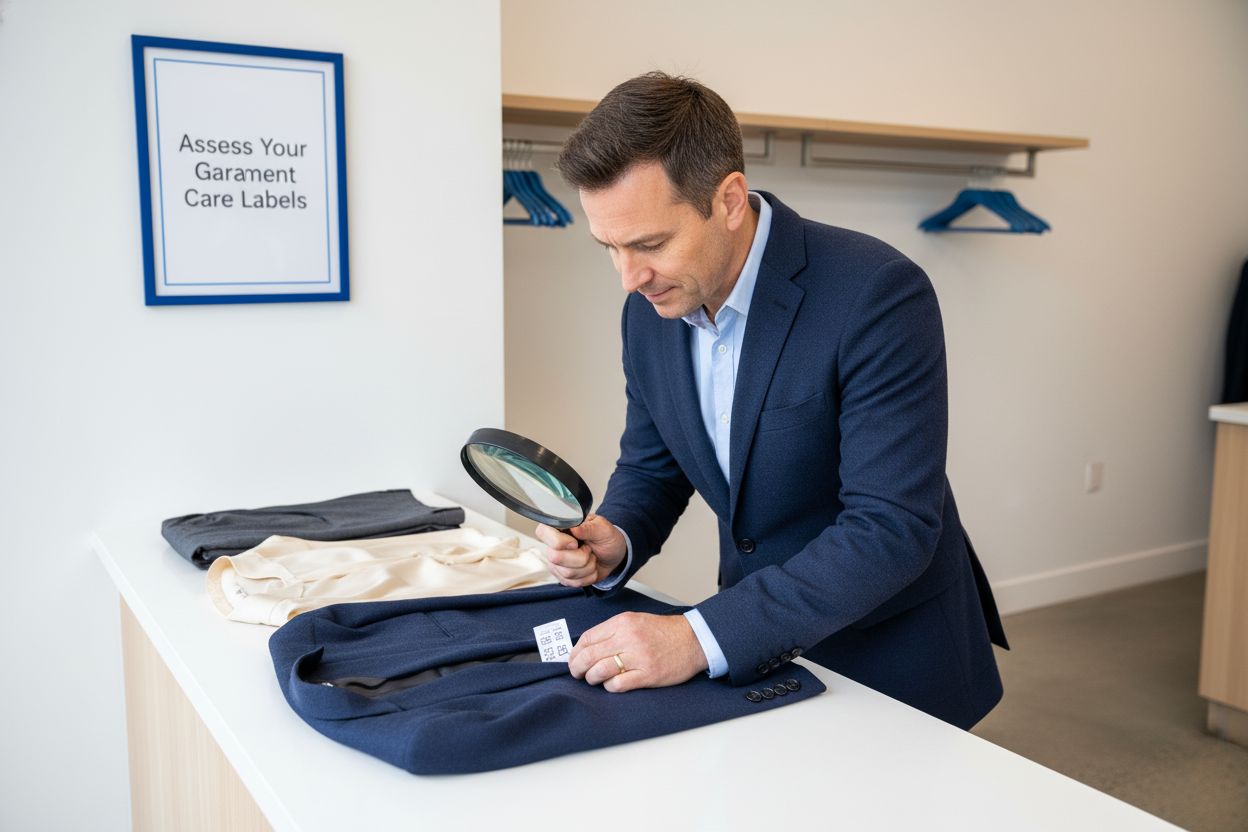How to Remove Static From Clothes for Good

If you need to get rid of static fast, grab a metal hanger. Just run it over the inside and outside of your clothes. You'll hear the crackle disappear as the hanger discharges all that built-up electricity, and just like that, the cling is gone. A light spritz of water or a quick wipe with a dryer sheet can also do the trick when you're in a pinch.
Why Your Clothes Have Static and How to Fix It Fast
That annoying, crackling cling you get when a skirt sticks to your legs isn’t just some random quirk—it's pure science. Static electricity happens when different fabrics rub together, especially in a tumble dryer, causing tiny electrons to jump from one material to another. This problem gets a lot worse in dry environments, like a room with the heat blasting in winter.

The real culprit here is a lack of moisture. When there's humidity in the air, it gives those electrical charges a natural escape route. But in dry air, the charges have nowhere to go, so they build up on your clothes. It’s why you'll notice static cling is a much bigger issue during those cold, dry winter months.
The Role of Fabric and Humidity
The type of fabric you're wearing plays a huge part in the static saga. If you're interested in the nitty-gritty, understanding different fabric properties like organic cotton vs. bamboo can shed some light on how different materials behave. Synthetic fibers like polyester and nylon are basically magnets for static because they don't hold onto moisture, creating the perfect storm for an electrical charge to build up.
The link between humidity and static is pretty dramatic. When the relative humidity in a room drops below 45%, you've got ideal conditions for static. Think about this: walking across a vinyl floor in a room with 15% humidity can generate up to 12,000 volts of static electricity. Crank that humidity up to 80%, and the charge drops to just 1,500 volts—a massive decrease of nearly 88%!
Quick Tip: If you're constantly fighting static at home, the air is probably too dry. A simple humidifier can make a world of difference, not just for your clothes but for your skin and sinuses, too.
Immediate Fixes for Static Emergencies
When you're already dressed and about to walk out the door, you don’t have time for a full laundry cycle. You need a solution that works right now.
Here’s a quick-reference guide for getting rid of static on the fly.
Immediate Static Removal Techniques
These on-the-spot tricks are fantastic, but the best long-term strategy is to tackle static before it even starts—right in the laundry room. Using the right products, like fabric softener, can make a huge difference. You can learn more by checking out our guide on what fabric softener is used for and how its anti-static properties work.
Building a Static-Free Laundry Routine
The fight against static cling is won long before you get dressed. It actually starts right in your laundry room. Think of it less as a chore and more as your best line of defense—a proactive strategy instead of a last-minute fix. A few small, smart habits can make a huge difference in cutting down the friction and dryness that make your favorite clothes stick together.

This isn't about adding complicated steps to your wash day. It’s about being a little more intentional with the cycles you’re already running. Once you understand how different fabrics interact and how your machines can either help or hurt, you can stop static right at the source.
Strategic Sorting and Washing
The first move in a smart routine is always thoughtful sorting. You probably already separate your lights and darks, but sorting by fabric type is just as important for controlling static. Synthetic fabrics like polyester and nylon are notorious static generators, especially when they rub up against natural fibers like cotton in the wash.
When you wash these different fabric types in separate loads, you dramatically cut down on the friction that creates an electrical charge in the first place. This simple change can mean way less static to deal with later. To really get it right, it helps to start with solid general garment washing guidelines.
Using a liquid fabric softener in the rinse cycle is another one of my go-to methods. These softeners coat fabric surfaces with compounds that make them slightly conductive, which lets electrical charges dissipate harmlessly instead of building up into a shocking surprise.
A Note on Alternatives: If you’re not a fan of commercial fabric softeners, no problem. Just add a half-cup of white vinegar to your rinse cycle. It works wonders by cutting through detergent residue, which often leaves fabrics stiff and more prone to static.
Mastering Your Dryer Settings
The dryer is where most static is born, and the main culprit is over-drying. When clothes are zapped until they’re bone-dry, the inside of that tumbler becomes the perfect storm for static generation. Your goal should be to pull your clothes out while they are still just slightly damp.
Here are a few ways to nail this without having to babysit your machine:
- Use Moisture-Sensing Cycles: So many modern dryers have this feature, and it’s a game-changer. The machine uses sensors to detect moisture levels and automatically shuts off when the clothes are dry, preventing you from accidentally over-drying them.
- Lower the Heat: High heat might seem faster, but it also sucks all the moisture out of the air inside the dryer, which cranks up the static. I always opt for a lower heat setting and just let it run a bit longer.
- Don't Overload the Machine: When you cram the dryer full, you’re just asking for trouble. It kills the airflow, which means clothes tumble against each other constantly, creating more friction and taking longer to dry anyway.
Dryer Tools for a Static-Free Finish
Beyond your dryer’s settings, a few simple tools can make a huge difference. Dryer sheets are the classic choice, but there are some other great options out there.
Wool dryer balls are a fantastic, reusable alternative. They work by physically separating clothes as they tumble, which boosts airflow and can even shorten drying time by 10-25%. Less friction, less time, less static. For an extra anti-static kick, try pinning a safety pin to one of the wool balls. The metal helps discharge the electrical buildup as it tumbles.
And if you stick with dryer sheets, make sure you're using them right. Just tossing one on top of a full load isn't going to cut it. For the best results, bury the sheet in the middle of the load. This helps it circulate and distribute its anti-static magic evenly across all your clothes. It’s a tiny adjustment that makes a big impact.
Clever DIY and On-the-Go Static Solutions
Static cling has the worst timing. It doesn’t politely wait until you’re near your laundry room. It strikes when you’re already out the door, turning a fantastic outfit into an awkward, clingy disaster.
The good news? You can fight back with a few clever tricks using things you probably already have. No matter where you are, you can neutralize that static in seconds.

These on-the-go fixes all work on one simple principle: adding a bit of moisture or conductivity to break the static charge. You don't need fancy anti-static products—just a little resourcefulness.
Create a Homemade Anti-Static Spray
One of the most effective ways to zap static from clothes is with a simple DIY spray you can whip up in minutes. This is my personal lifesaver, and I always keep a little travel-sized bottle of it in my car for static emergencies.
All you need is a spray bottle and one of these easy formulas:
- Fabric Softener Method: Mix one part liquid fabric softener with ten parts water. The same agents that soften your clothes also leave a residue that stops static from building up in the first place.
- Hair Conditioner Method: No fabric softener? A small dollop of hair conditioner mixed with water works just as well. It coats the fabric fibers in a similar way, instantly breaking the cling.
Just give the bottle a good shake and lightly mist the inside of your garment. The key is a fine mist, not soaking the fabric. It dries almost immediately and leaves your clothes totally static-free. It's a great alternative to commercial sprays and uses things you already own.
For those who lean toward more natural solutions in the wash cycle itself, a mix of baking soda and vinegar can also do wonders to soften fabrics. You can learn more in our guide to washing clothes with baking soda and vinegar.
Pro Tip: If you're caught without a spray bottle, just dampen your hands with a little water and lightly brush them over the clingy spots on your clothes. That tiny bit of moisture is often all it takes to discharge the static immediately.
Quick Fixes Using Everyday Items
When static catches you off guard, the solution might be right there in your bag or on your desk. These remedies are perfect for when you need a discreet and immediate fix.
Applying a bit of unscented lotion to your skin is a fantastic two-for-one trick. It moisturizes your skin while creating a barrier that stops static-prone fabrics from sticking to you. This works especially well for skirts and dresses clinging to your legs.
Another surprisingly powerful tool is a simple dryer sheet. I always tell people to keep one folded up in a small plastic bag in their purse or desk drawer. Just wipe it over the staticky area. The anti-static agents transfer right to the fabric, instantly releasing the cling. It’s probably the single fastest way to solve the problem when you're on the move.
Long-Term Strategies for a Static-Free Wardrobe
Tired of doing the last-minute "static dance" right before you head out the door? The best way to deal with static isn't just about quick fixes—it's about preventing it from happening in the first place. When you shift your focus from frantic remedies to building some simple long-term habits, you can create a wardrobe where static just doesn’t stand a chance.

This proactive approach is all about making small, smart adjustments to your home and how you choose your clothes. It really comes down to understanding the root causes of static—super dry air and certain types of fabric—and tackling them directly.
Control Your Home’s Environment
One of the biggest culprits behind static cling is a simple lack of moisture in the air. Dry environments, which are especially common in the winter when the heat is blasting, create the perfect storm for static charges to build up on your favorite outfits.
A surprisingly easy solution is to introduce a little more humidity into your home. Running a humidifier in your bedroom or near your closet can make a world of difference. By keeping the indoor humidity at a more balanced level, you give those electrical charges a natural escape route, stopping them from latching onto your clothes.
Make Smart Fabric Choices
Your wardrobe itself can be your first and best line of defense against static. We all have those pieces that seem to attract static no matter what—and there's a reason for that. Certain fabrics are just far more prone to generating static than others. Synthetics like polyester, nylon, and acrylic are notorious for this because they don't absorb moisture well, basically turning them into magnets for static electricity.
To build a more static-resistant closet, try to prioritize natural fibers when you can.
- Cotton: This breathable, absorbent fiber is a terrible conductor of electricity, making it one of your best allies in the fight against static.
- Linen: Just like cotton, linen is a natural material that shrugs off static build-up.
- Wool: While it can sometimes generate a little static, wool holds onto more moisture than synthetics, which helps keep the cling to a minimum.
This doesn't mean you have to ditch all your synthetic pieces, but just being mindful of the fabric tag when you're shopping can save you a lot of frustration down the road.
You might be surprised to learn that managing static is far from a modern problem. Historical records show that controlling static electricity was a critical safety measure centuries ago! Some of the earliest formal procedures were documented way back in the 1400s to prevent gunpowder explosions in military forts. Today's simple solutions are the result of a long history of innovation. You can discover more insights about the history of static control on Antistat.com.
To help you out, here’s a quick rundown of which fabrics are the most and least likely to give you trouble.
Fabric Static Propensity Guide
Knowing which materials are the usual suspects can make a huge difference in how you wash, dry, and even shop for your clothes.
Upgrade Your Closet Storage
Even the way you store your clothes can play a part in a static-free life. Here’s a simple yet surprisingly effective trick: switch from plastic hangers to metal hangers.
Metal is a fantastic conductor. That means it will continuously and safely discharge any static that builds up on your garments while they’re just hanging out in the closet. It's a small change, but it ensures your clothes are neutralized before you even think about putting them on, solving the problem before it even starts.
When to Call in the Pros for Laundry
Let's be real: home remedies and laundry hacks are amazing for most everyday static issues. But every so often, you come across a garment that seems to have a personal vendetta against you, clinging for dear life no matter what you try.
Knowing when to pass the torch to a professional isn't admitting defeat. It’s about making a smart choice to give your clothes the expert care they deserve, especially when you're dealing with stubborn static on delicate or expensive items.
Sometimes, despite your best efforts with dryer sheets and safety pins, the static just won't budge. This is super common with certain high-end synthetic blends or structured pieces. Professional cleaners have access to commercial-grade anti-static treatments and specialized equipment that can safely neutralize those frustrating electrical charges in a way our home setups just can't match.
For Your Most Delicate Garments
Delicate fabrics are the number one reason to call in a professional. Think about materials like silk, chiffon, velvet, or anything with a lot of embellishments like sequins or beading. The very things we use to fight static at home—friction and heat in the dryer—can completely ruin these fabrics. Plus, trying to use anti-static sprays on them can leave behind water spots or other damage.
For these special items, professional dry cleaning is your safest bet. The process uses a controlled environment and specific solvents that clean fabric thoroughly without the aggressive tumbling that creates static in the first place. Your favorite formal dress or that silk blouse will come back looking pristine and, most importantly, cling-free.
The Value of Real Expertise
Think of a professional laundry service as another tool in your clothing care kit. For those irreplaceable items or that expensive wool winter coat that seems to attract static from a mile away, trusting an expert is just plain smart. They know exactly how different materials react and can apply the right treatments without risking the fabric's integrity.
When you invest in professional care, you're not just paying for cleaning—you're paying for peace of mind. Experts can diagnose persistent static issues that might be linked to fabric finish or residue buildup, offering a more permanent solution.
Ultimately, for those tough cases or when you just want to know your best clothes are getting the best care, a professional service is invaluable. To get a better idea of everything they can do, our guide to professional laundry services takes a deeper dive into the benefits of letting the experts take over.
Answering Your Questions About Static Cling
Even after you've tried all the tricks in the book, static cling can still be a bit of a mystery. It’s one of those household frustrations that just keeps coming back. We get a lot of questions about it, so we've put together some quick answers for those specific static situations that seem to pop up time and time again.
Think of this as your go-to guide for figuring out any lingering static problems.
Why Do My Clothes Get Static In The Winter But Not Summer?
That's a fantastic question, and the answer is all about one thing: humidity.
Winter air is notoriously dry, especially inside our homes when the heat is cranking. That lack of moisture in the air creates the perfect storm for static electricity, preventing the electrical charges on your clothes from going anywhere. They just build and build.
Summer, on the other hand, is the complete opposite. The air is naturally humid. All those water molecules provide a perfect escape route for static charges, neutralizing them before your favorite skirt decides to attach itself to your legs. This is exactly why a humidifier can be your secret weapon for fighting static long-term.
Can Certain Fabrics Make Static Worse?
Oh, absolutely. The material your clothes are made of plays a massive role in the static battle. Synthetic fabrics are almost always the main offenders because they just don't absorb moisture well, which lets static charges build up with nowhere to go.
You’ll want to keep an eye on these usual suspects:
- Polyester and Nylon: These are magnets for static, especially when they tumble around and rub against other clothes in the dryer.
- Acrylic: This is a big one for sweaters and blankets, and it's a major static generator.
Natural fibers like cotton, linen, and wool are much better at keeping static at bay. They naturally hold onto more moisture, which helps dissipate any electrical charge before it becomes a problem.
Key Takeaway: If you're constantly fighting static with a particular outfit, take a peek at the fabric tag. There's a good chance it's a synthetic blend that just needs a little extra anti-static care when you do the laundry.
Do Wool Dryer Balls Actually Stop Static?
Wool dryer balls are great for cutting down on static, but they go about it differently than dryer sheets. Their main job is to bounce around and separate your clothes while they tumble, which really improves airflow and helps everything dry faster. Since over-drying is a huge cause of static, they tackle the problem at its source.
That said, when the air is bone-dry, you might still get a little bit of cling. Here's a pro trick for that: just pin a safety pin to one or two of the dryer balls. The metal acts like a tiny lightning rod, collecting and discharging the static buildup as it tumbles through your laundry. It’s a simple, effective way to give yourself an extra layer of static defense.
Still fighting with stubborn static on your delicate or expensive garments? Sometimes, the best solution is to let a professional handle it. Columbia Pike Laundry offers expert dry cleaning and laundry services with convenient pickup and delivery, giving you back your time and peace of mind. Let us make sure your favorite clothes are returned perfectly clean and completely static-free.
Popular Blog Articles

Meet the Author
Daniel Logan didn’t start CPL because he loved laundry. He started it because his family was drowning in time debt, and laundry was one of the biggest weights.
Mornings were chaos with two kids under 5. Evenings felt like catch-up. And weekends? Gone to sorting socks and folding piles.
He knew his story wasn’t unique. So he built a business that gave families like his just a little bit of breathing room one load at a time.
With no laundry experience but deep tech skills, Daniel rolled up his sleeves, doing every job himself while building systems that turned it into a modern laundry service that saves customers time, simplifies their lives, and delivers reliability they can count on.
That’s where CPL began. Not from a playbook, but from pain. From one dad trying to buy back time: for himself, and for every household like his.





